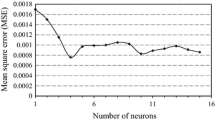Abstract
In recent years, the Artificial Neural Network (ANN) modelling that has been used in the solution of the complex problems has gained an increasing interest in soil science. The ANN modelling is also getting more popular in soil mechanics applications. It is a preferable method among the other approaching methods because of having quick results in test phase in short time. This paper describes the ANN models for estimating undrained shear strength (Su) of cohesive soils from SPT (Standard Penetration Test) data with index properties in Turkey. The performance of the ANN models is investigated using different input variables such as measured N, corrected N (N60) value, natural water content (wn), liquid limit (wL), plasticity index (Ip). In this study the ANN models are compared to empirical methods. The results indicate the superior performance of ANN models over the empirical methods.
Similar content being viewed by others
References
M. W. Gardner and S. R. Dorling, “Artificial Neural Networks (the Multilayer Perception)—A Review of Applications in the Atmospheric Sciences,” Atm. Environ. 32(14/15), 2627–2636 (1998).
H. T. Durgunoglu and E. Togrol, “Penetration Testing in Turkey: State-of-the-Art Report,” Proc. of the 1st European Symp. on Penetration Testing (Stockholm, Sweden, 1974) p. 137.
L. Décourt, “The Standard Penetration Test: State-of-the-Art-Report,” Norwegian Geotechnical Institute Publication No. 179, (Oslo, Norway, 1990), p. 1–12.
H. M. Horn, “North American Experience in Sampling and Laboratory Dynamic Testing,” ASTM Geotechn. Testing J. 2(2), 84–97 (1979).
H. Mori, “Review of Japanese Subsurface Investigation Techniques,” J. South East Asian Soc. Geotechn. Engin. 10, 219–242 (1979).
I. K. Nixon, “Standard Penetration Test: State of the Art Report,” Proc. of the 2nd Eur. Symp. on Penetration Testing (Amsterdam, the Netherlands, 1982), pp. 3–21.
D. P. Coduto, Foundation Design: Principles and Practice (Prentice-Hall, USA, 1994).
B. B. Broms and N. Flodin, “History of Soil Penetration Testing,” Proc. of 1st Intern. Symp. on Penetration Testing (Orlando, Norway, 1988), pp. 157–220.
J. McGregor and J. M. Duncan, Performance and Use of the Standard Penetration Test in Geotechnical Engineering Practice Report of CGPR (Virginia Polytechnic Institute and State University, Virginia, 1998).
S. Saran, Analysis and Design of Substructure (Balkema, Rotterdam, 1996).
M. A. Stroud, “The Standard Penetration Test in Insensitive Clays and Soft Rock,” Proc. of the 1st European Symp. on Penetration Testing (Stockholm, Sweden, 1974).
O. Sivrikaya and E. Toğrol, “Relations between SPT-N and qu,” 5th Intern. Congress on Advances in Civil Engineering (Istanbul, Turkey, 2002), pp. 943–952.
V. De Mello, “The Standard Penetration Test — A State-of-the-Art Report,” Proc. of the 4th Pan-American Conf. on Soil Mechanics and Foundation Engineering (San Juan, Puerto Rico, 1971).
J. K. Mitchell, F. Guzikowski, and W. C. B. Villet, “The Measurement of Soil Properties in Situ: Present Methods, Their Applicability and Potential,” Lawrence Berkeley Lab. Rep. No. 6363 (Univ. of California, Berkeley, 1978).
C. R. I. Clayton, “SPT Energy Transmission: Theory, Measurement and Significance,” Ground Engin. 23(10), 35–43 (1990).
H. B. Seed, K. Tokimatsu, L. F. Harder, and R. M. Chung, “Influence of SPT Procedures in Soil Liquefaction Resistance Evaluations,” ASCE J. Geotech. Engin. 111(12), 1425–1445 (1985).
A. W. Skempton, “Standard Penetration Test Procedures and the Effects in Sands of Overburden Pressure, Relative Density, Particle Size, Aging and Overconsolidation,” Geotechnique 36(3), 425–447 (1986).
K. Tokimatsu, “Penetration Tests for Dynamic Problems,” Proc. of the 1st Intern. Symp. on Penetration Testing (Orlando, Norway, 1988).
N. Kartam, I. Flood, and J. H. Garrett, Artificial Neural Networks for Civil Engineers: Fundamentals and Applications (ASCE, New York, 1997).
I. Flood and N. Kartam, “Neural Network in Civil Engineering I: Principles and Understandings,” ASCE J. Comput. Civil Eng. 8(2), 131–148 (1994).
I. Flood and N. Kartam, “Neural Network in Civil engineering II: Systems and Applications,” ASCE J. Comput. Civil Eng. 8(2), 149–162 (1994).
M. A. Shahin, M. B. Jaksa, and H. R. Maier, “Artificial Neural Network Applications in Geotechnical Engineering,” Austr. Geomech., 49–62 (2001).
Y. Zhou and X. Wu, “Use of Neural Networks in the Analysis and Interpretation of Site Investigation Data,” Computer and Geotechnics 16, 105–122 (1994).
D. M. Rizzo and D. E. Dougherty, “Application of Artificial Neural Network for Site Characterization Using Hard and Soft Information,” Proc. of 10th Intern. Conf. on Computational Methods in Water Resources (Kluwer Academic, Dordrecht, 1994), Part 12, pp. 793–799.
V. Cal, “Neural Network-Alternative to Pile Driving Formulas,” Adv. Engin. Software 22(2), 95–97 (1995).
P. U. Kurup, N. K. Dudani, “Neural Networks for Profiling Stress History of Clays from PCPT Data,” ASCE J. Geotechn. Geoenviron. Engin. 128(7), 569–579 (2002).
D. Penumadu, L. Jin-Nan, J. L. Chameau, and S. Arumugam, “Rate Dependant Behavior of Clays Using Neural Networks,” Proc. of the 13th Intern. Conf. on Soil Mechanics and Foundation Engineering (New Delhi, India, 1994).
W. T. Chan, Y. K. Chow, and L. F. Liu, “Neural Network-Alternative to Pile Driving Formulas,” Comp. Geotechn. 17(2), 135–156 (1995).
I. M. Lee and J. H. Lee, “Prediction of Pile Bearing Capacity Using Artificial Neural Networks,” Comp. Geotechn. 18(3), 189–200 (1996).
A. T. C. Goh, “Neural Network Modeling of CPT Seismic Liquefaction Data,” ASCE J. Geotechn. Engin. 122(1), 70–73 (1996).
D. Ural and H. Saka, “Liquefaction Prediction by Neural Networks,” Electr. J. Geotechn. Engin., 1089–3032 (1998).
Y. M. Najjar, I. A. Basheer, and W. A. Naouss, “On the Identification of Compaction Characteristics by Neuronets,” Comp. Geotechn. 18(3), 167–187 (1996).
I. A. Basheer, “Empirical Modeling of the Compaction Curve of Cohesive Soils,” Can. Geotechn. J. 38 29–45 (2001).
M. M. Gribb and G. W. Gribb, “Use of Neural Networks for Hydraulic Conductivity Determination in Unsaturated Soil,” Proc. 2nd Intern. Conf. on Ground Water Ecology (Atlanta, USA, 1994), pp. 155–163.
S. Akbulut, “Artificial Neural Networks for Predicting the Hydraulic Conductivity of Coarse-Grained Soils,” Eur. Soil Sci. 38(4), 392–398 (2005).
Author information
Authors and Affiliations
Corresponding author
Additional information
The article is published in the original.
Rights and permissions
About this article
Cite this article
Sivrikaya, O. Comparison of Artificial Neural Networks models with correlative works on undrained shear strength. Eurasian Soil Sc. 42, 1487–1496 (2009). https://doi.org/10.1134/S1064229309130092
Published:
Issue Date:
DOI: https://doi.org/10.1134/S1064229309130092




